Smart Grid Optimization: Supply-side and Demand-side Management
VerifiedAdded on 2021/06/18
|25
|12965
|73
Report
AI Summary
This report, submitted as part of an assignment at the University of Wollongong, Australia, explores the optimization of smart grids, focusing on both demand-side and supply-side management. The paper investigates the integration of renewable energy sources, distributed energy storage, and distributed energy generation within the smart grid framework. It highlights the importance of smart meters and demand response mechanisms in achieving optimal power regulation, cost reduction, and user privacy. The report also discusses the challenges and solutions related to voltage regulation, communication protocols, and the integration of distributed generation. Furthermore, it reviews existing literature on real-time pricing, stochastic modeling, and linear programming techniques used to minimize energy costs and improve energy efficiency. The paper proposes the use of Business-to-Grid (B2G) model for optimization, aiming to reduce monetary expenses through energy production and storage rather than solely relying on purchasing from the grid. The report emphasizes the need for advanced control structures, forecasting technologies, and the implementation of Demand-Side Management (DSM) strategies to facilitate a more efficient and sustainable smart grid system.
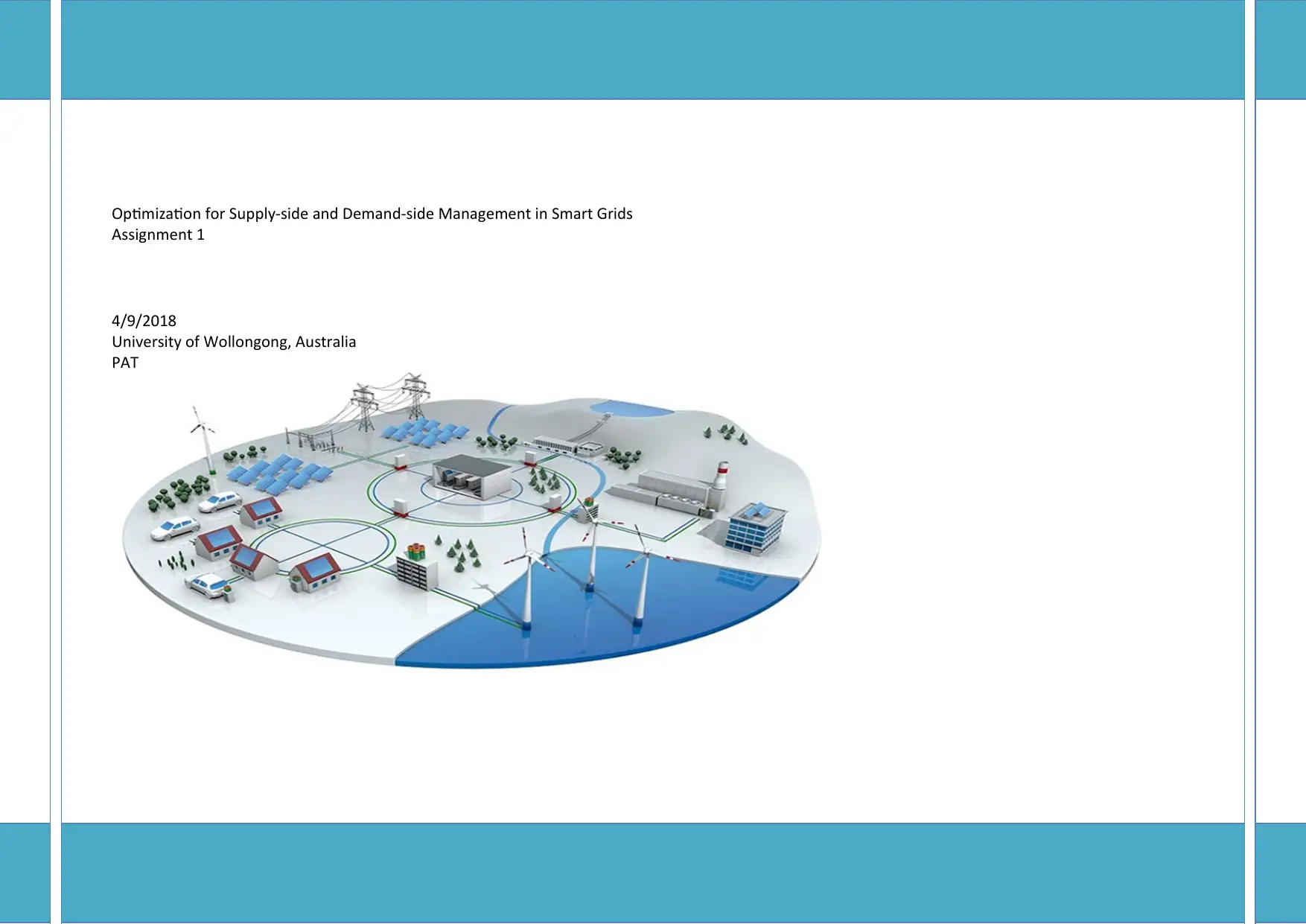
Optimization for Supply-side and Demand-side Management in Smart Grids
Assignment 1
4/9/2018
University of Wollongong, Australia
PAT
1
Assignment 1
4/9/2018
University of Wollongong, Australia
PAT
1
Paraphrase This Document
Need a fresh take? Get an instant paraphrase of this document with our AI Paraphraser
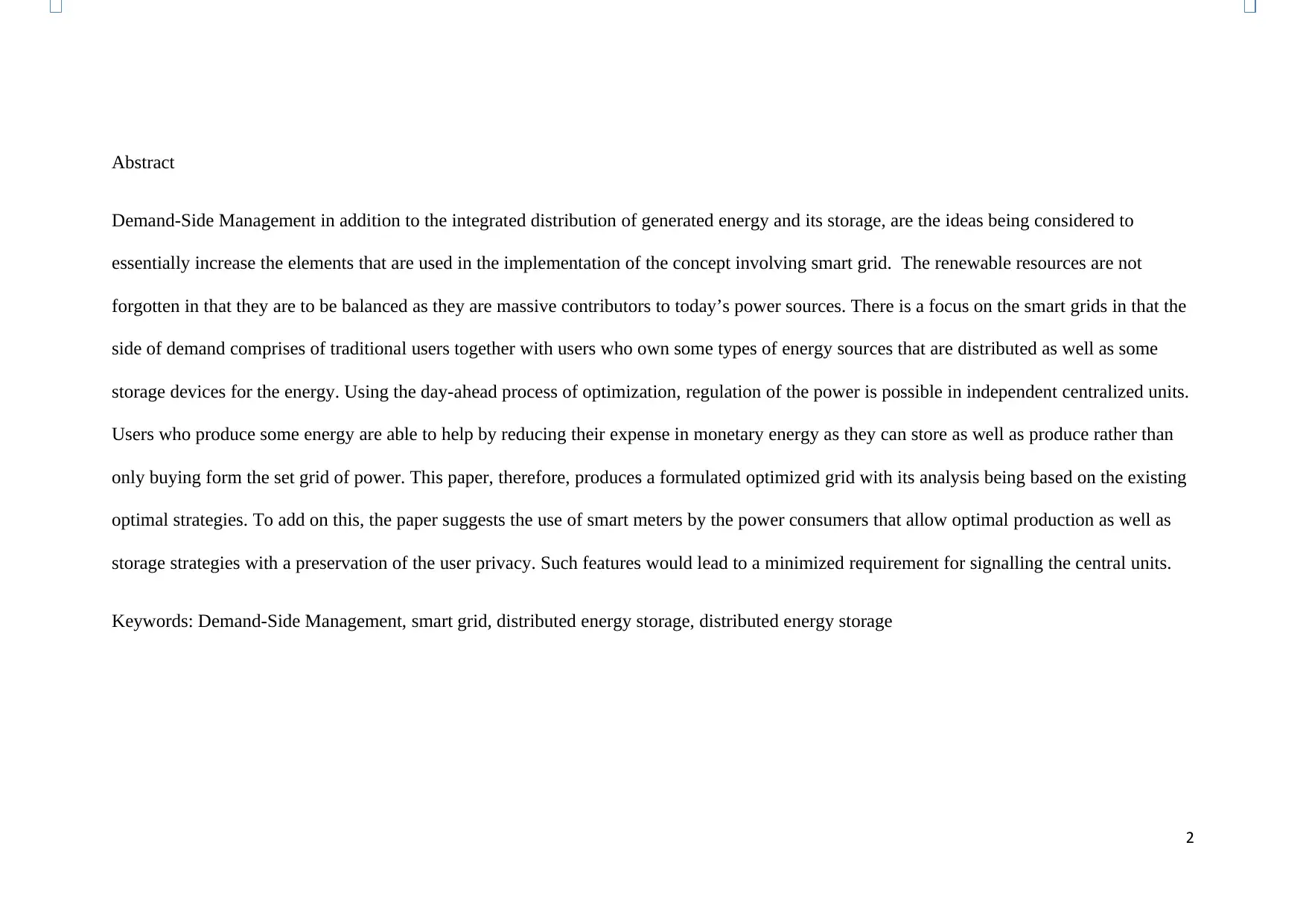
Abstract
Demand-Side Management in addition to the integrated distribution of generated energy and its storage, are the ideas being considered to
essentially increase the elements that are used in the implementation of the concept involving smart grid. The renewable resources are not
forgotten in that they are to be balanced as they are massive contributors to today’s power sources. There is a focus on the smart grids in that the
side of demand comprises of traditional users together with users who own some types of energy sources that are distributed as well as some
storage devices for the energy. Using the day-ahead process of optimization, regulation of the power is possible in independent centralized units.
Users who produce some energy are able to help by reducing their expense in monetary energy as they can store as well as produce rather than
only buying form the set grid of power. This paper, therefore, produces a formulated optimized grid with its analysis being based on the existing
optimal strategies. To add on this, the paper suggests the use of smart meters by the power consumers that allow optimal production as well as
storage strategies with a preservation of the user privacy. Such features would lead to a minimized requirement for signalling the central units.
Keywords: Demand-Side Management, smart grid, distributed energy storage, distributed energy storage
2
Demand-Side Management in addition to the integrated distribution of generated energy and its storage, are the ideas being considered to
essentially increase the elements that are used in the implementation of the concept involving smart grid. The renewable resources are not
forgotten in that they are to be balanced as they are massive contributors to today’s power sources. There is a focus on the smart grids in that the
side of demand comprises of traditional users together with users who own some types of energy sources that are distributed as well as some
storage devices for the energy. Using the day-ahead process of optimization, regulation of the power is possible in independent centralized units.
Users who produce some energy are able to help by reducing their expense in monetary energy as they can store as well as produce rather than
only buying form the set grid of power. This paper, therefore, produces a formulated optimized grid with its analysis being based on the existing
optimal strategies. To add on this, the paper suggests the use of smart meters by the power consumers that allow optimal production as well as
storage strategies with a preservation of the user privacy. Such features would lead to a minimized requirement for signalling the central units.
Keywords: Demand-Side Management, smart grid, distributed energy storage, distributed energy storage
2
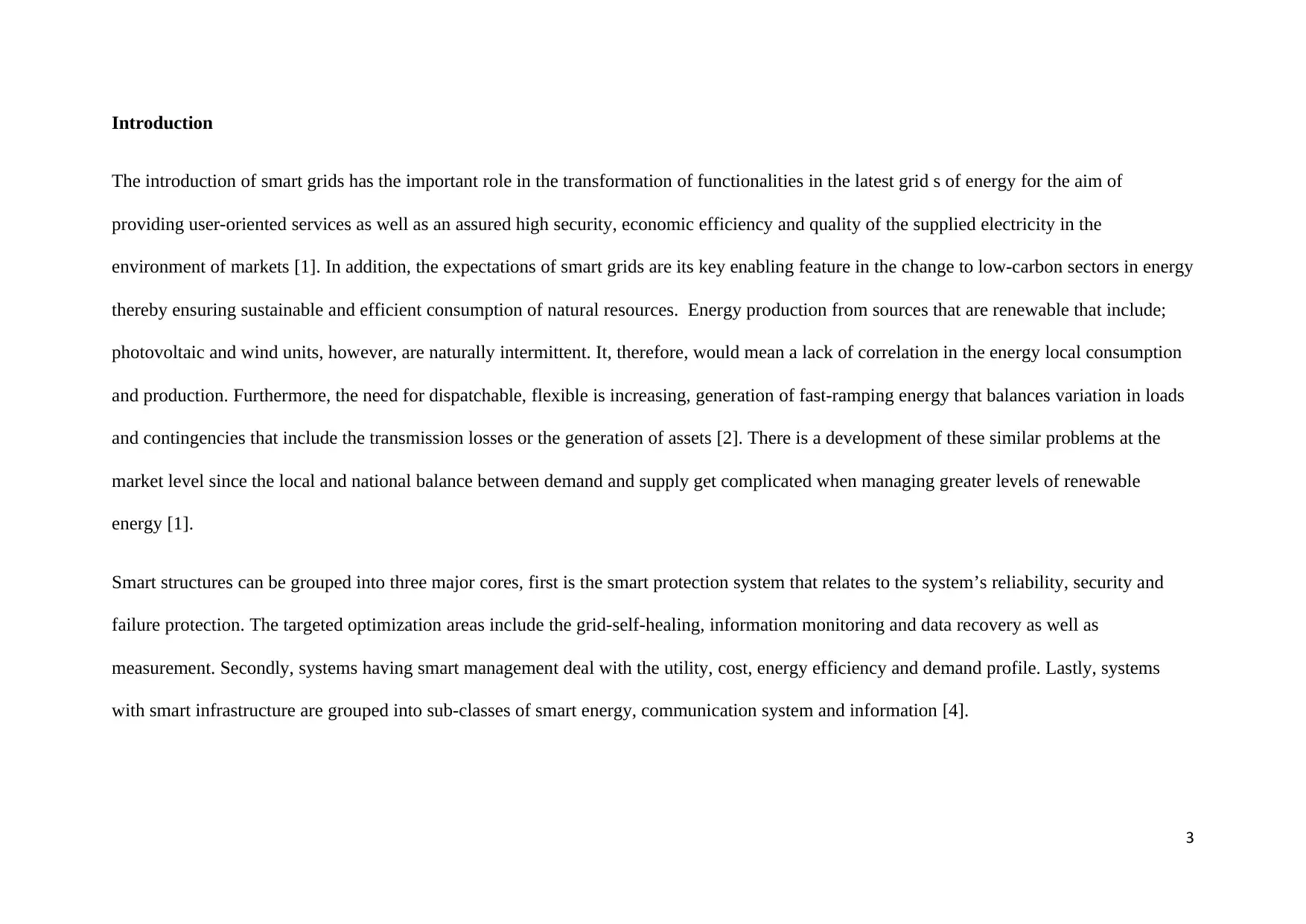
Introduction
The introduction of smart grids has the important role in the transformation of functionalities in the latest grid s of energy for the aim of
providing user-oriented services as well as an assured high security, economic efficiency and quality of the supplied electricity in the
environment of markets [1]. In addition, the expectations of smart grids are its key enabling feature in the change to low-carbon sectors in energy
thereby ensuring sustainable and efficient consumption of natural resources. Energy production from sources that are renewable that include;
photovoltaic and wind units, however, are naturally intermittent. It, therefore, would mean a lack of correlation in the energy local consumption
and production. Furthermore, the need for dispatchable, flexible is increasing, generation of fast-ramping energy that balances variation in loads
and contingencies that include the transmission losses or the generation of assets [2]. There is a development of these similar problems at the
market level since the local and national balance between demand and supply get complicated when managing greater levels of renewable
energy [1].
Smart structures can be grouped into three major cores, first is the smart protection system that relates to the system’s reliability, security and
failure protection. The targeted optimization areas include the grid-self-healing, information monitoring and data recovery as well as
measurement. Secondly, systems having smart management deal with the utility, cost, energy efficiency and demand profile. Lastly, systems
with smart infrastructure are grouped into sub-classes of smart energy, communication system and information [4].
3
The introduction of smart grids has the important role in the transformation of functionalities in the latest grid s of energy for the aim of
providing user-oriented services as well as an assured high security, economic efficiency and quality of the supplied electricity in the
environment of markets [1]. In addition, the expectations of smart grids are its key enabling feature in the change to low-carbon sectors in energy
thereby ensuring sustainable and efficient consumption of natural resources. Energy production from sources that are renewable that include;
photovoltaic and wind units, however, are naturally intermittent. It, therefore, would mean a lack of correlation in the energy local consumption
and production. Furthermore, the need for dispatchable, flexible is increasing, generation of fast-ramping energy that balances variation in loads
and contingencies that include the transmission losses or the generation of assets [2]. There is a development of these similar problems at the
market level since the local and national balance between demand and supply get complicated when managing greater levels of renewable
energy [1].
Smart structures can be grouped into three major cores, first is the smart protection system that relates to the system’s reliability, security and
failure protection. The targeted optimization areas include the grid-self-healing, information monitoring and data recovery as well as
measurement. Secondly, systems having smart management deal with the utility, cost, energy efficiency and demand profile. Lastly, systems
with smart infrastructure are grouped into sub-classes of smart energy, communication system and information [4].
3
⊘ This is a preview!⊘
Do you want full access?
Subscribe today to unlock all pages.

Trusted by 1+ million students worldwide
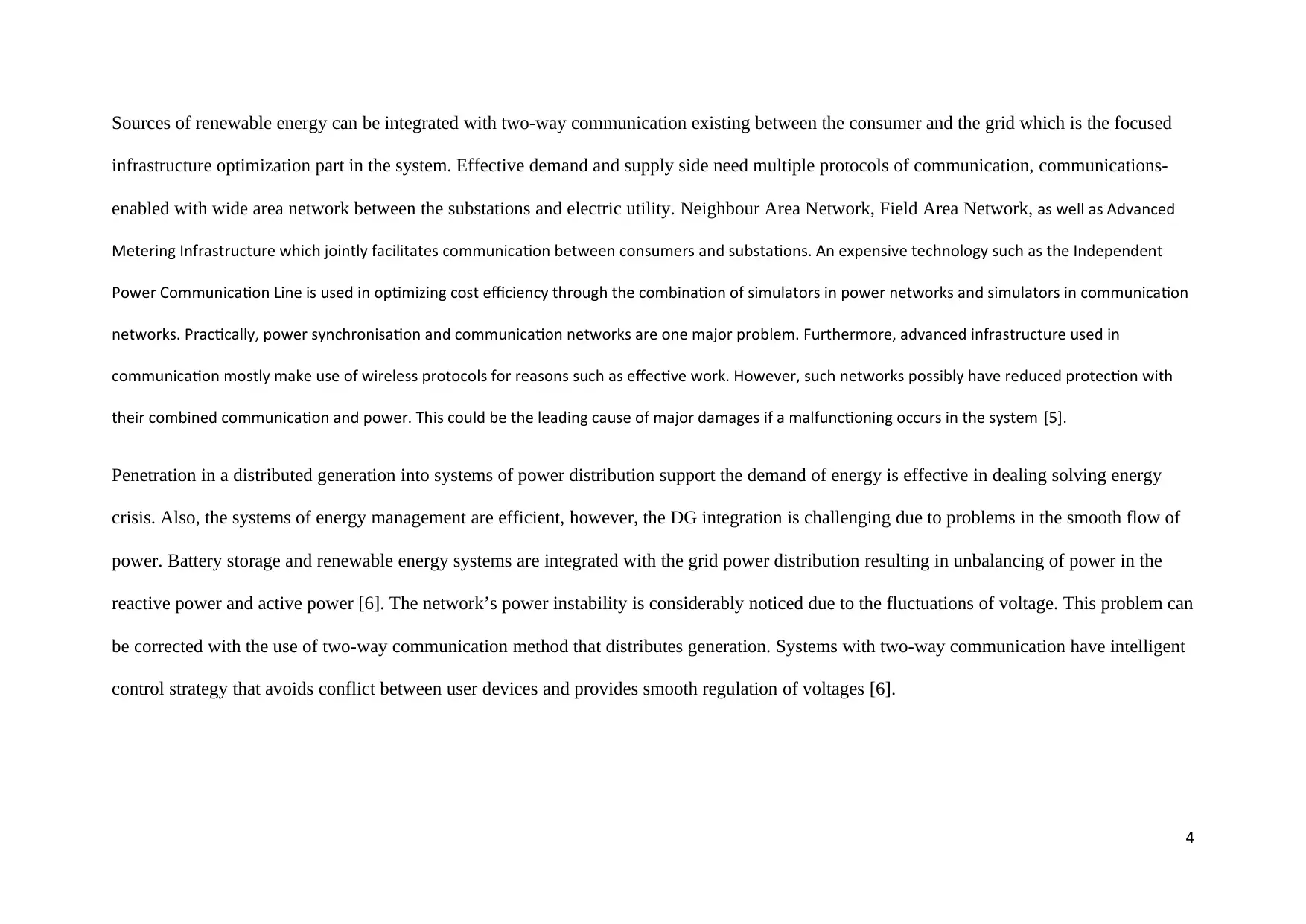
Sources of renewable energy can be integrated with two-way communication existing between the consumer and the grid which is the focused
infrastructure optimization part in the system. Effective demand and supply side need multiple protocols of communication, communications-
enabled with wide area network between the substations and electric utility. Neighbour Area Network, Field Area Network, as well as Advanced
Metering Infrastructure which jointly facilitates communication between consumers and substations. An expensive technology such as the Independent
Power Communication Line is used in optimizing cost efficiency through the combination of simulators in power networks and simulators in communication
networks. Practically, power synchronisation and communication networks are one major problem. Furthermore, advanced infrastructure used in
communication mostly make use of wireless protocols for reasons such as effective work. However, such networks possibly have reduced protection with
their combined communication and power. This could be the leading cause of major damages if a malfunctioning occurs in the system [5].
Penetration in a distributed generation into systems of power distribution support the demand of energy is effective in dealing solving energy
crisis. Also, the systems of energy management are efficient, however, the DG integration is challenging due to problems in the smooth flow of
power. Battery storage and renewable energy systems are integrated with the grid power distribution resulting in unbalancing of power in the
reactive power and active power [6]. The network’s power instability is considerably noticed due to the fluctuations of voltage. This problem can
be corrected with the use of two-way communication method that distributes generation. Systems with two-way communication have intelligent
control strategy that avoids conflict between user devices and provides smooth regulation of voltages [6].
4
infrastructure optimization part in the system. Effective demand and supply side need multiple protocols of communication, communications-
enabled with wide area network between the substations and electric utility. Neighbour Area Network, Field Area Network, as well as Advanced
Metering Infrastructure which jointly facilitates communication between consumers and substations. An expensive technology such as the Independent
Power Communication Line is used in optimizing cost efficiency through the combination of simulators in power networks and simulators in communication
networks. Practically, power synchronisation and communication networks are one major problem. Furthermore, advanced infrastructure used in
communication mostly make use of wireless protocols for reasons such as effective work. However, such networks possibly have reduced protection with
their combined communication and power. This could be the leading cause of major damages if a malfunctioning occurs in the system [5].
Penetration in a distributed generation into systems of power distribution support the demand of energy is effective in dealing solving energy
crisis. Also, the systems of energy management are efficient, however, the DG integration is challenging due to problems in the smooth flow of
power. Battery storage and renewable energy systems are integrated with the grid power distribution resulting in unbalancing of power in the
reactive power and active power [6]. The network’s power instability is considerably noticed due to the fluctuations of voltage. This problem can
be corrected with the use of two-way communication method that distributes generation. Systems with two-way communication have intelligent
control strategy that avoids conflict between user devices and provides smooth regulation of voltages [6].
4
Paraphrase This Document
Need a fresh take? Get an instant paraphrase of this document with our AI Paraphraser
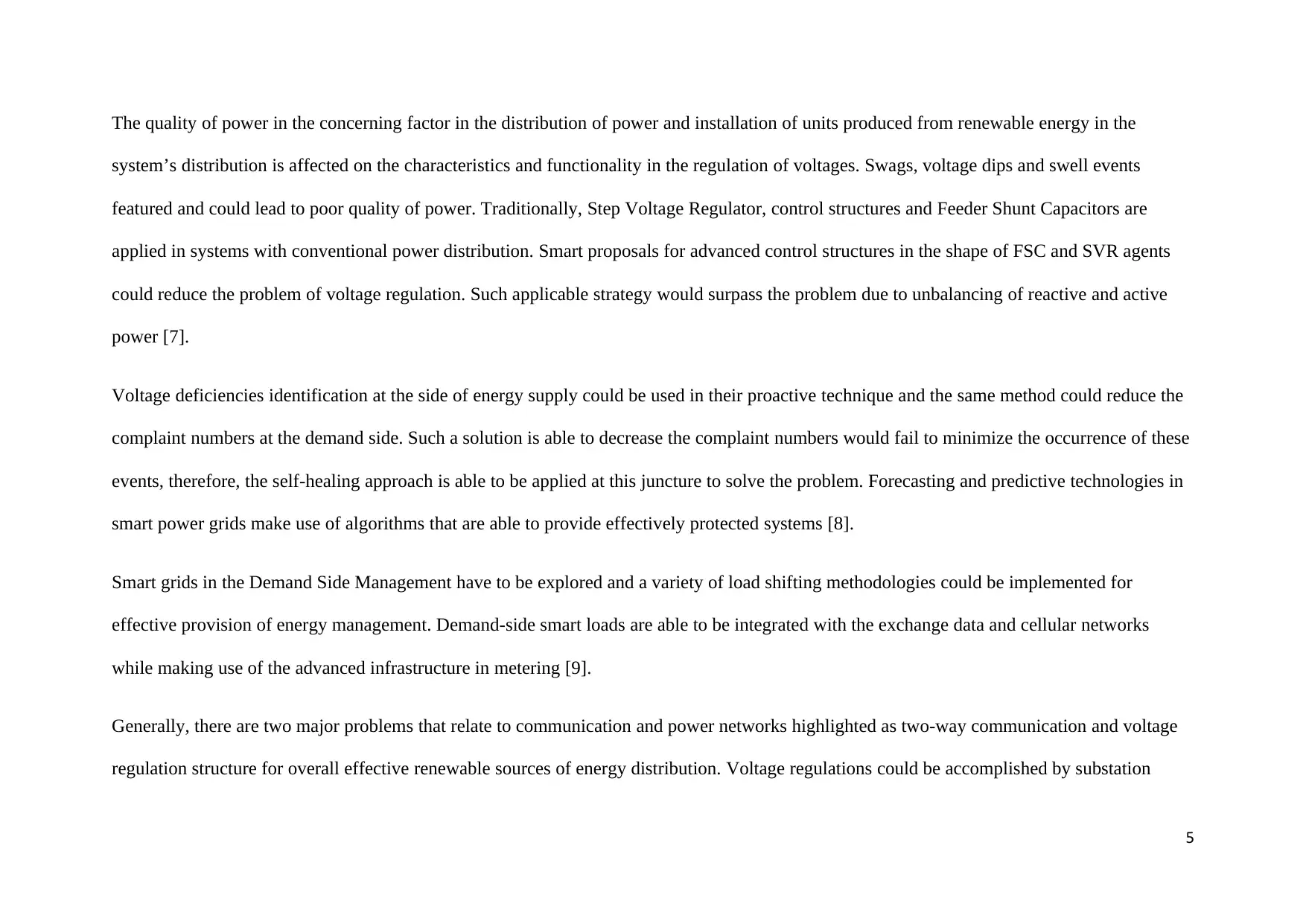
The quality of power in the concerning factor in the distribution of power and installation of units produced from renewable energy in the
system’s distribution is affected on the characteristics and functionality in the regulation of voltages. Swags, voltage dips and swell events
featured and could lead to poor quality of power. Traditionally, Step Voltage Regulator, control structures and Feeder Shunt Capacitors are
applied in systems with conventional power distribution. Smart proposals for advanced control structures in the shape of FSC and SVR agents
could reduce the problem of voltage regulation. Such applicable strategy would surpass the problem due to unbalancing of reactive and active
power [7].
Voltage deficiencies identification at the side of energy supply could be used in their proactive technique and the same method could reduce the
complaint numbers at the demand side. Such a solution is able to decrease the complaint numbers would fail to minimize the occurrence of these
events, therefore, the self-healing approach is able to be applied at this juncture to solve the problem. Forecasting and predictive technologies in
smart power grids make use of algorithms that are able to provide effectively protected systems [8].
Smart grids in the Demand Side Management have to be explored and a variety of load shifting methodologies could be implemented for
effective provision of energy management. Demand-side smart loads are able to be integrated with the exchange data and cellular networks
while making use of the advanced infrastructure in metering [9].
Generally, there are two major problems that relate to communication and power networks highlighted as two-way communication and voltage
regulation structure for overall effective renewable sources of energy distribution. Voltage regulations could be accomplished by substation
5
system’s distribution is affected on the characteristics and functionality in the regulation of voltages. Swags, voltage dips and swell events
featured and could lead to poor quality of power. Traditionally, Step Voltage Regulator, control structures and Feeder Shunt Capacitors are
applied in systems with conventional power distribution. Smart proposals for advanced control structures in the shape of FSC and SVR agents
could reduce the problem of voltage regulation. Such applicable strategy would surpass the problem due to unbalancing of reactive and active
power [7].
Voltage deficiencies identification at the side of energy supply could be used in their proactive technique and the same method could reduce the
complaint numbers at the demand side. Such a solution is able to decrease the complaint numbers would fail to minimize the occurrence of these
events, therefore, the self-healing approach is able to be applied at this juncture to solve the problem. Forecasting and predictive technologies in
smart power grids make use of algorithms that are able to provide effectively protected systems [8].
Smart grids in the Demand Side Management have to be explored and a variety of load shifting methodologies could be implemented for
effective provision of energy management. Demand-side smart loads are able to be integrated with the exchange data and cellular networks
while making use of the advanced infrastructure in metering [9].
Generally, there are two major problems that relate to communication and power networks highlighted as two-way communication and voltage
regulation structure for overall effective renewable sources of energy distribution. Voltage regulations could be accomplished by substation
5
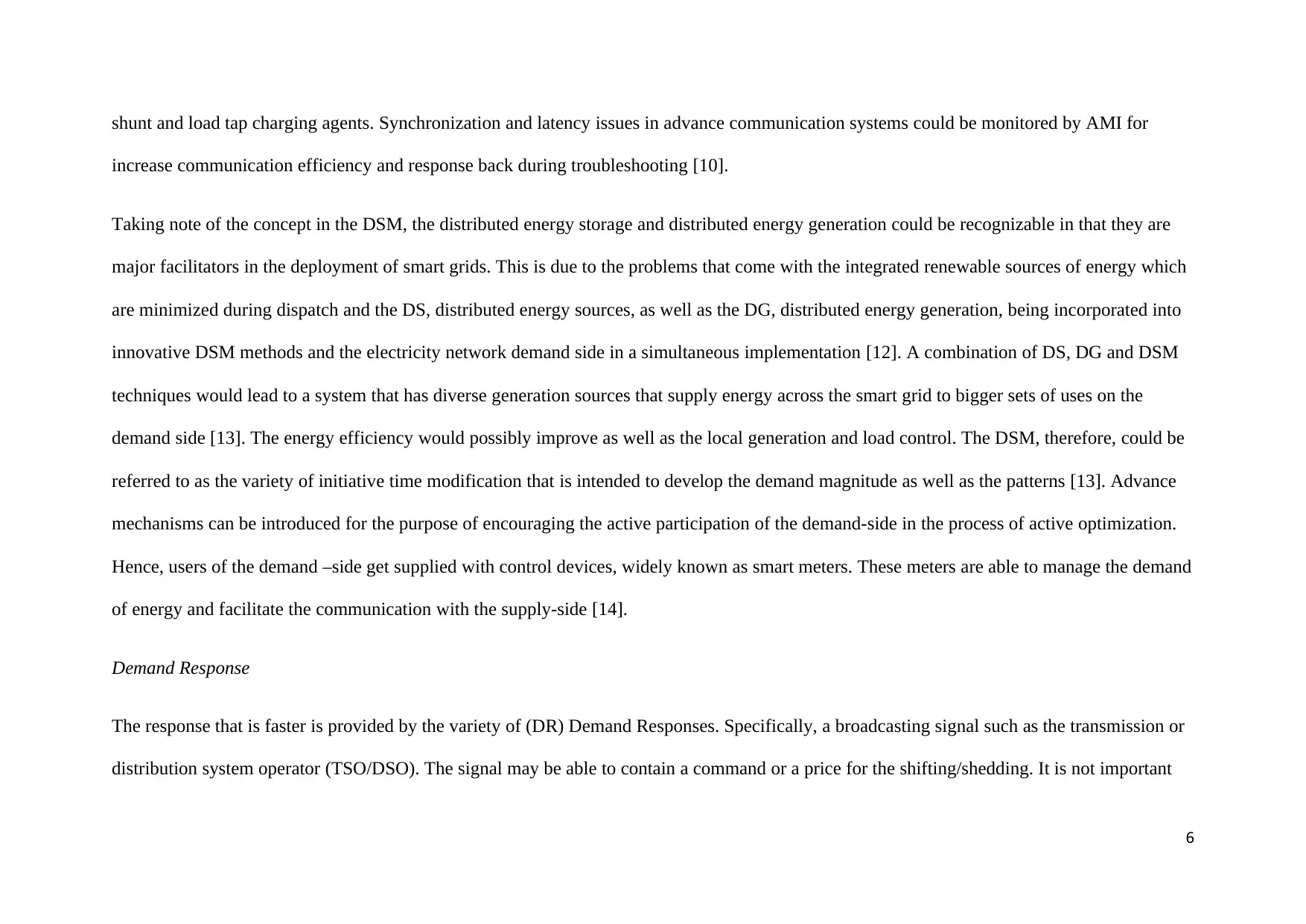
shunt and load tap charging agents. Synchronization and latency issues in advance communication systems could be monitored by AMI for
increase communication efficiency and response back during troubleshooting [10].
Taking note of the concept in the DSM, the distributed energy storage and distributed energy generation could be recognizable in that they are
major facilitators in the deployment of smart grids. This is due to the problems that come with the integrated renewable sources of energy which
are minimized during dispatch and the DS, distributed energy sources, as well as the DG, distributed energy generation, being incorporated into
innovative DSM methods and the electricity network demand side in a simultaneous implementation [12]. A combination of DS, DG and DSM
techniques would lead to a system that has diverse generation sources that supply energy across the smart grid to bigger sets of uses on the
demand side [13]. The energy efficiency would possibly improve as well as the local generation and load control. The DSM, therefore, could be
referred to as the variety of initiative time modification that is intended to develop the demand magnitude as well as the patterns [13]. Advance
mechanisms can be introduced for the purpose of encouraging the active participation of the demand-side in the process of active optimization.
Hence, users of the demand –side get supplied with control devices, widely known as smart meters. These meters are able to manage the demand
of energy and facilitate the communication with the supply-side [14].
Demand Response
The response that is faster is provided by the variety of (DR) Demand Responses. Specifically, a broadcasting signal such as the transmission or
distribution system operator (TSO/DSO). The signal may be able to contain a command or a price for the shifting/shedding. It is not important
6
increase communication efficiency and response back during troubleshooting [10].
Taking note of the concept in the DSM, the distributed energy storage and distributed energy generation could be recognizable in that they are
major facilitators in the deployment of smart grids. This is due to the problems that come with the integrated renewable sources of energy which
are minimized during dispatch and the DS, distributed energy sources, as well as the DG, distributed energy generation, being incorporated into
innovative DSM methods and the electricity network demand side in a simultaneous implementation [12]. A combination of DS, DG and DSM
techniques would lead to a system that has diverse generation sources that supply energy across the smart grid to bigger sets of uses on the
demand side [13]. The energy efficiency would possibly improve as well as the local generation and load control. The DSM, therefore, could be
referred to as the variety of initiative time modification that is intended to develop the demand magnitude as well as the patterns [13]. Advance
mechanisms can be introduced for the purpose of encouraging the active participation of the demand-side in the process of active optimization.
Hence, users of the demand –side get supplied with control devices, widely known as smart meters. These meters are able to manage the demand
of energy and facilitate the communication with the supply-side [14].
Demand Response
The response that is faster is provided by the variety of (DR) Demand Responses. Specifically, a broadcasting signal such as the transmission or
distribution system operator (TSO/DSO). The signal may be able to contain a command or a price for the shifting/shedding. It is not important
6
⊘ This is a preview!⊘
Do you want full access?
Subscribe today to unlock all pages.

Trusted by 1+ million students worldwide
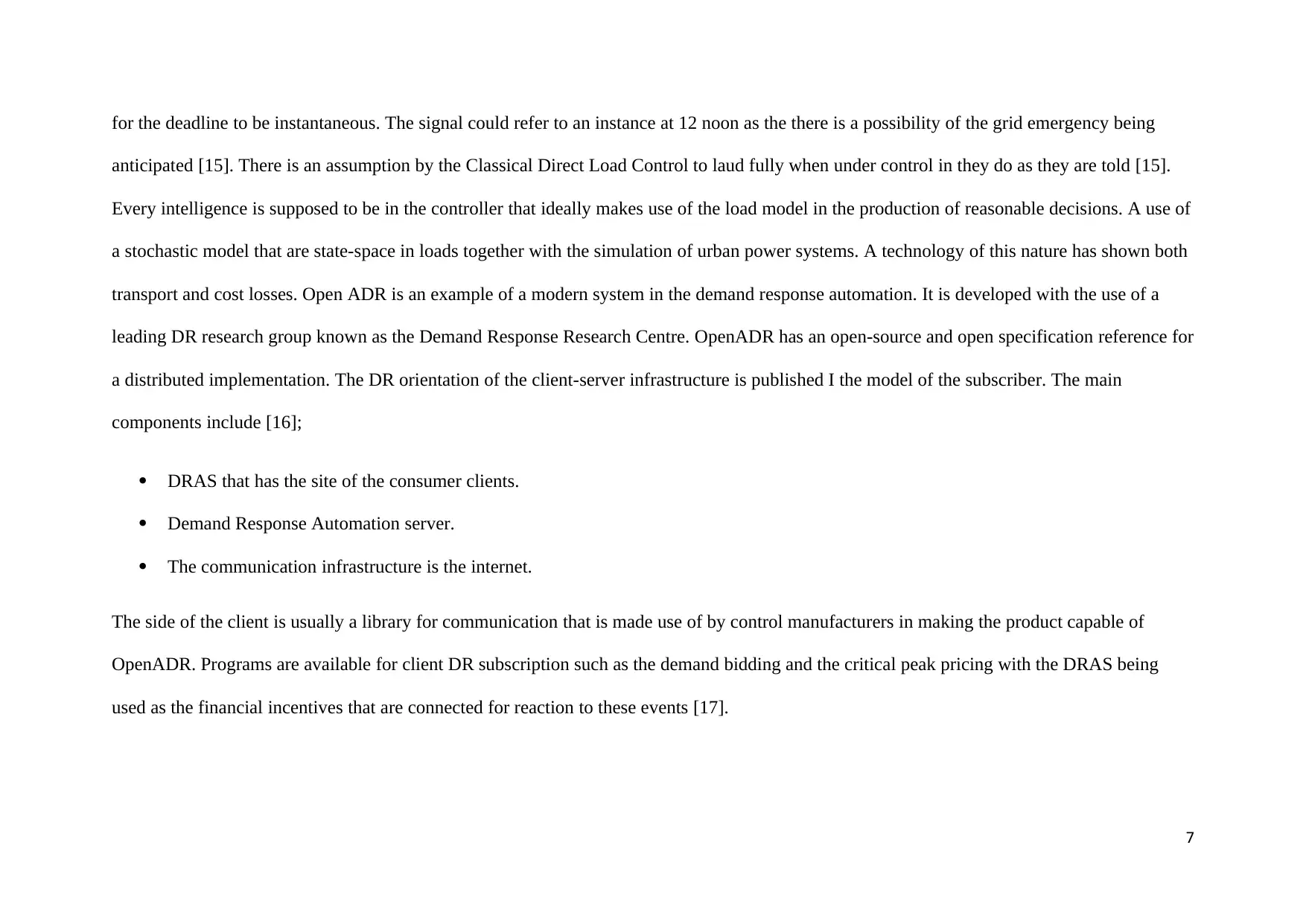
for the deadline to be instantaneous. The signal could refer to an instance at 12 noon as the there is a possibility of the grid emergency being
anticipated [15]. There is an assumption by the Classical Direct Load Control to laud fully when under control in they do as they are told [15].
Every intelligence is supposed to be in the controller that ideally makes use of the load model in the production of reasonable decisions. A use of
a stochastic model that are state-space in loads together with the simulation of urban power systems. A technology of this nature has shown both
transport and cost losses. Open ADR is an example of a modern system in the demand response automation. It is developed with the use of a
leading DR research group known as the Demand Response Research Centre. OpenADR has an open-source and open specification reference for
a distributed implementation. The DR orientation of the client-server infrastructure is published I the model of the subscriber. The main
components include [16];
DRAS that has the site of the consumer clients.
Demand Response Automation server.
The communication infrastructure is the internet.
The side of the client is usually a library for communication that is made use of by control manufacturers in making the product capable of
OpenADR. Programs are available for client DR subscription such as the demand bidding and the critical peak pricing with the DRAS being
used as the financial incentives that are connected for reaction to these events [17].
7
anticipated [15]. There is an assumption by the Classical Direct Load Control to laud fully when under control in they do as they are told [15].
Every intelligence is supposed to be in the controller that ideally makes use of the load model in the production of reasonable decisions. A use of
a stochastic model that are state-space in loads together with the simulation of urban power systems. A technology of this nature has shown both
transport and cost losses. Open ADR is an example of a modern system in the demand response automation. It is developed with the use of a
leading DR research group known as the Demand Response Research Centre. OpenADR has an open-source and open specification reference for
a distributed implementation. The DR orientation of the client-server infrastructure is published I the model of the subscriber. The main
components include [16];
DRAS that has the site of the consumer clients.
Demand Response Automation server.
The communication infrastructure is the internet.
The side of the client is usually a library for communication that is made use of by control manufacturers in making the product capable of
OpenADR. Programs are available for client DR subscription such as the demand bidding and the critical peak pricing with the DRAS being
used as the financial incentives that are connected for reaction to these events [17].
7
Paraphrase This Document
Need a fresh take? Get an instant paraphrase of this document with our AI Paraphraser
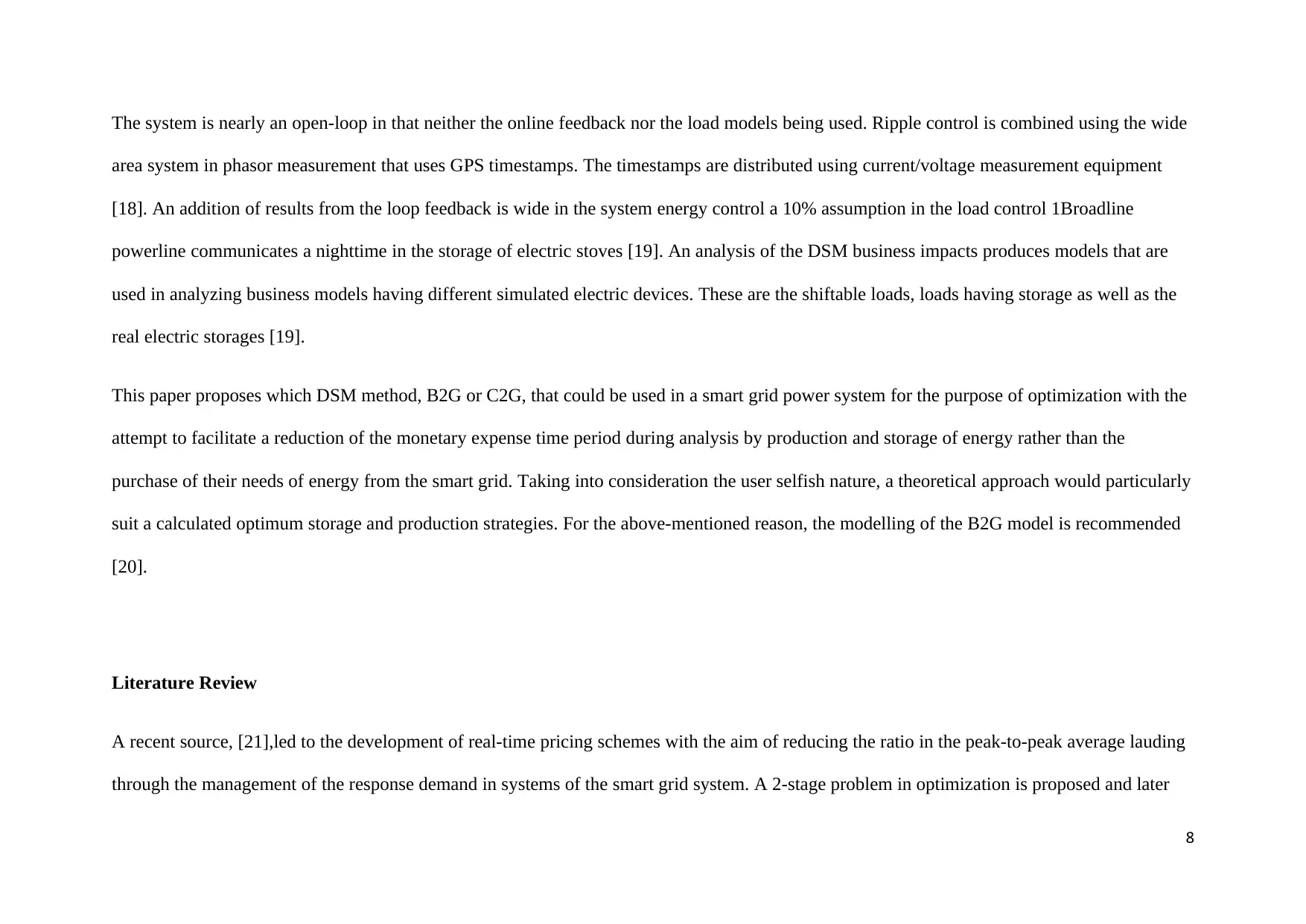
The system is nearly an open-loop in that neither the online feedback nor the load models being used. Ripple control is combined using the wide
area system in phasor measurement that uses GPS timestamps. The timestamps are distributed using current/voltage measurement equipment
[18]. An addition of results from the loop feedback is wide in the system energy control a 10% assumption in the load control 1Broadline
powerline communicates a nighttime in the storage of electric stoves [19]. An analysis of the DSM business impacts produces models that are
used in analyzing business models having different simulated electric devices. These are the shiftable loads, loads having storage as well as the
real electric storages [19].
This paper proposes which DSM method, B2G or C2G, that could be used in a smart grid power system for the purpose of optimization with the
attempt to facilitate a reduction of the monetary expense time period during analysis by production and storage of energy rather than the
purchase of their needs of energy from the smart grid. Taking into consideration the user selfish nature, a theoretical approach would particularly
suit a calculated optimum storage and production strategies. For the above-mentioned reason, the modelling of the B2G model is recommended
[20].
Literature Review
A recent source, [21],led to the development of real-time pricing schemes with the aim of reducing the ratio in the peak-to-peak average lauding
through the management of the response demand in systems of the smart grid system. A 2-stage problem in optimization is proposed and later
8
area system in phasor measurement that uses GPS timestamps. The timestamps are distributed using current/voltage measurement equipment
[18]. An addition of results from the loop feedback is wide in the system energy control a 10% assumption in the load control 1Broadline
powerline communicates a nighttime in the storage of electric stoves [19]. An analysis of the DSM business impacts produces models that are
used in analyzing business models having different simulated electric devices. These are the shiftable loads, loads having storage as well as the
real electric storages [19].
This paper proposes which DSM method, B2G or C2G, that could be used in a smart grid power system for the purpose of optimization with the
attempt to facilitate a reduction of the monetary expense time period during analysis by production and storage of energy rather than the
purchase of their needs of energy from the smart grid. Taking into consideration the user selfish nature, a theoretical approach would particularly
suit a calculated optimum storage and production strategies. For the above-mentioned reason, the modelling of the B2G model is recommended
[20].
Literature Review
A recent source, [21],led to the development of real-time pricing schemes with the aim of reducing the ratio in the peak-to-peak average lauding
through the management of the response demand in systems of the smart grid system. A 2-stage problem in optimization is proposed and later
8
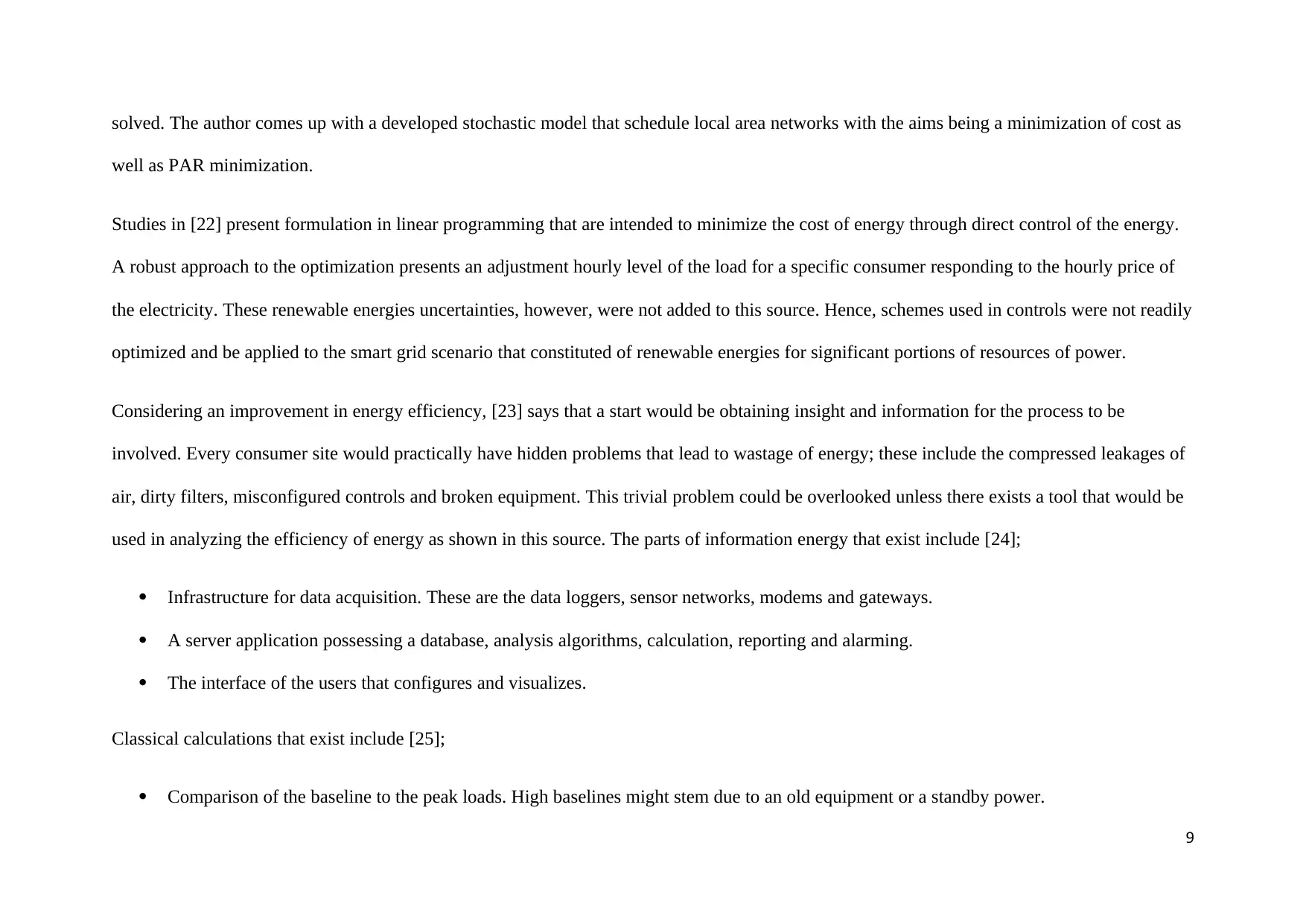
solved. The author comes up with a developed stochastic model that schedule local area networks with the aims being a minimization of cost as
well as PAR minimization.
Studies in [22] present formulation in linear programming that are intended to minimize the cost of energy through direct control of the energy.
A robust approach to the optimization presents an adjustment hourly level of the load for a specific consumer responding to the hourly price of
the electricity. These renewable energies uncertainties, however, were not added to this source. Hence, schemes used in controls were not readily
optimized and be applied to the smart grid scenario that constituted of renewable energies for significant portions of resources of power.
Considering an improvement in energy efficiency, [23] says that a start would be obtaining insight and information for the process to be
involved. Every consumer site would practically have hidden problems that lead to wastage of energy; these include the compressed leakages of
air, dirty filters, misconfigured controls and broken equipment. This trivial problem could be overlooked unless there exists a tool that would be
used in analyzing the efficiency of energy as shown in this source. The parts of information energy that exist include [24];
Infrastructure for data acquisition. These are the data loggers, sensor networks, modems and gateways.
A server application possessing a database, analysis algorithms, calculation, reporting and alarming.
The interface of the users that configures and visualizes.
Classical calculations that exist include [25];
Comparison of the baseline to the peak loads. High baselines might stem due to an old equipment or a standby power.
9
well as PAR minimization.
Studies in [22] present formulation in linear programming that are intended to minimize the cost of energy through direct control of the energy.
A robust approach to the optimization presents an adjustment hourly level of the load for a specific consumer responding to the hourly price of
the electricity. These renewable energies uncertainties, however, were not added to this source. Hence, schemes used in controls were not readily
optimized and be applied to the smart grid scenario that constituted of renewable energies for significant portions of resources of power.
Considering an improvement in energy efficiency, [23] says that a start would be obtaining insight and information for the process to be
involved. Every consumer site would practically have hidden problems that lead to wastage of energy; these include the compressed leakages of
air, dirty filters, misconfigured controls and broken equipment. This trivial problem could be overlooked unless there exists a tool that would be
used in analyzing the efficiency of energy as shown in this source. The parts of information energy that exist include [24];
Infrastructure for data acquisition. These are the data loggers, sensor networks, modems and gateways.
A server application possessing a database, analysis algorithms, calculation, reporting and alarming.
The interface of the users that configures and visualizes.
Classical calculations that exist include [25];
Comparison of the baseline to the peak loads. High baselines might stem due to an old equipment or a standby power.
9
⊘ This is a preview!⊘
Do you want full access?
Subscribe today to unlock all pages.

Trusted by 1+ million students worldwide
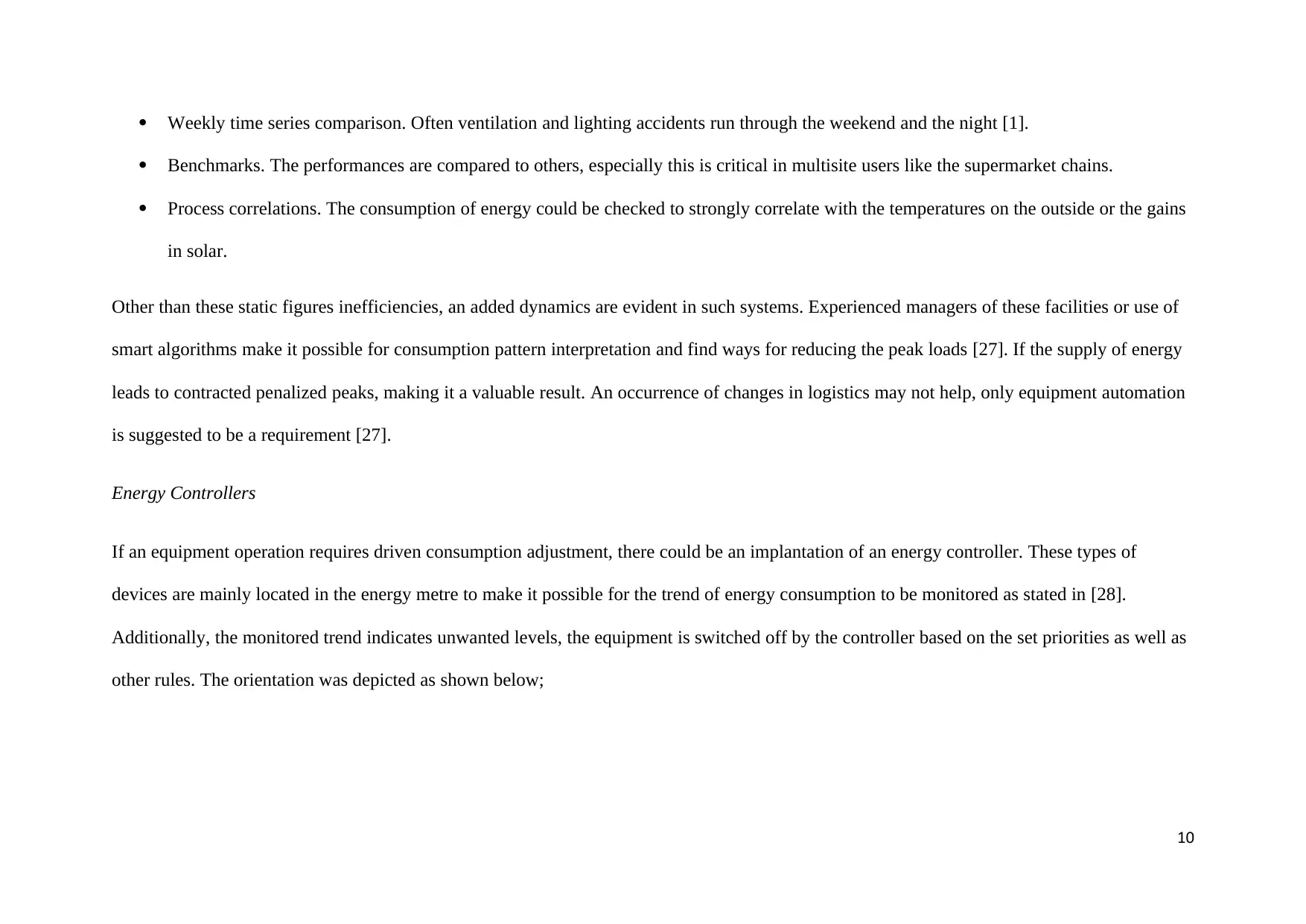
Weekly time series comparison. Often ventilation and lighting accidents run through the weekend and the night [1].
Benchmarks. The performances are compared to others, especially this is critical in multisite users like the supermarket chains.
Process correlations. The consumption of energy could be checked to strongly correlate with the temperatures on the outside or the gains
in solar.
Other than these static figures inefficiencies, an added dynamics are evident in such systems. Experienced managers of these facilities or use of
smart algorithms make it possible for consumption pattern interpretation and find ways for reducing the peak loads [27]. If the supply of energy
leads to contracted penalized peaks, making it a valuable result. An occurrence of changes in logistics may not help, only equipment automation
is suggested to be a requirement [27].
Energy Controllers
If an equipment operation requires driven consumption adjustment, there could be an implantation of an energy controller. These types of
devices are mainly located in the energy metre to make it possible for the trend of energy consumption to be monitored as stated in [28].
Additionally, the monitored trend indicates unwanted levels, the equipment is switched off by the controller based on the set priorities as well as
other rules. The orientation was depicted as shown below;
10
Benchmarks. The performances are compared to others, especially this is critical in multisite users like the supermarket chains.
Process correlations. The consumption of energy could be checked to strongly correlate with the temperatures on the outside or the gains
in solar.
Other than these static figures inefficiencies, an added dynamics are evident in such systems. Experienced managers of these facilities or use of
smart algorithms make it possible for consumption pattern interpretation and find ways for reducing the peak loads [27]. If the supply of energy
leads to contracted penalized peaks, making it a valuable result. An occurrence of changes in logistics may not help, only equipment automation
is suggested to be a requirement [27].
Energy Controllers
If an equipment operation requires driven consumption adjustment, there could be an implantation of an energy controller. These types of
devices are mainly located in the energy metre to make it possible for the trend of energy consumption to be monitored as stated in [28].
Additionally, the monitored trend indicates unwanted levels, the equipment is switched off by the controller based on the set priorities as well as
other rules. The orientation was depicted as shown below;
10
Paraphrase This Document
Need a fresh take? Get an instant paraphrase of this document with our AI Paraphraser
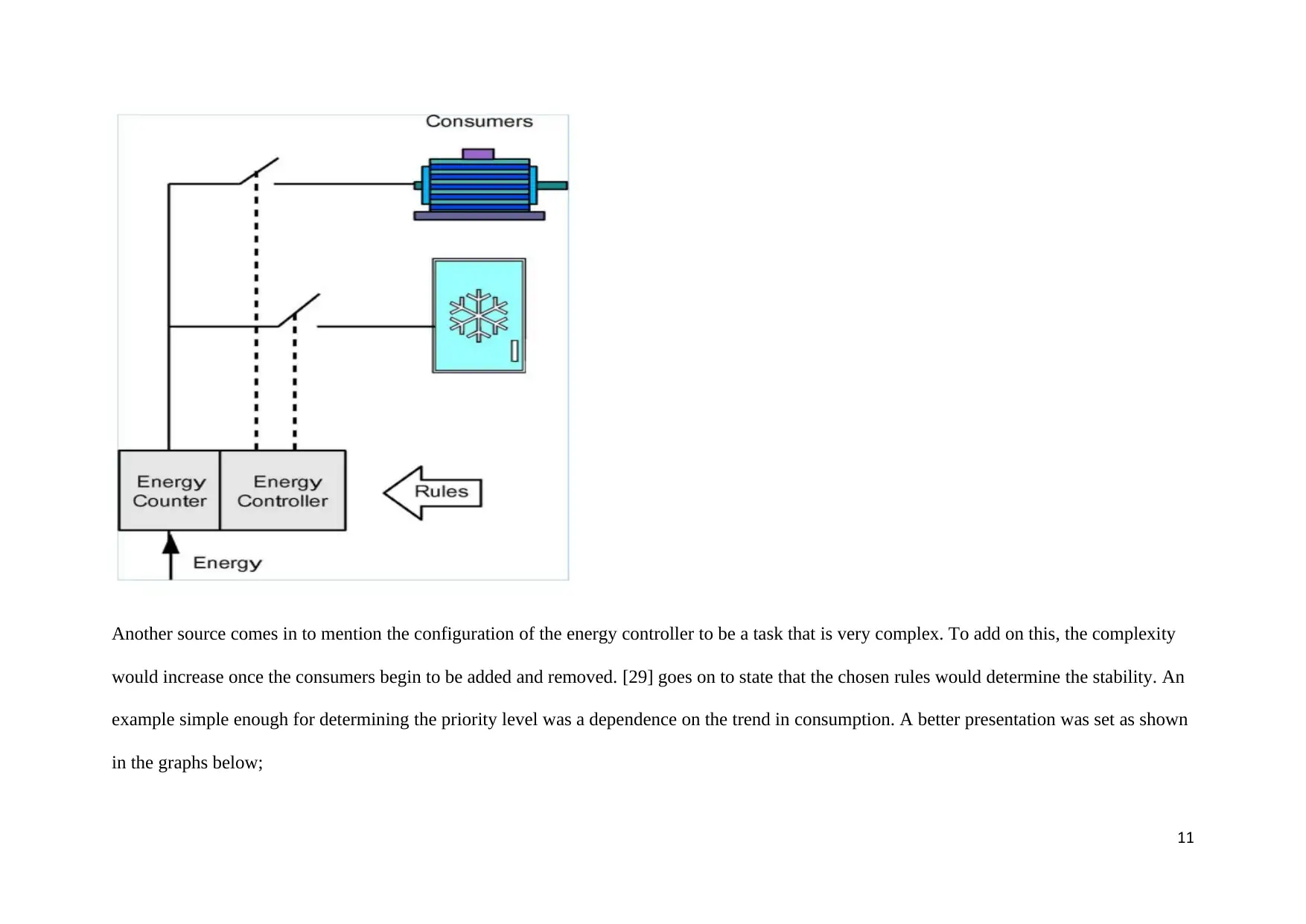
Another source comes in to mention the configuration of the energy controller to be a task that is very complex. To add on this, the complexity
would increase once the consumers begin to be added and removed. [29] goes on to state that the chosen rules would determine the stability. An
example simple enough for determining the priority level was a dependence on the trend in consumption. A better presentation was set as shown
in the graphs below;
11
would increase once the consumers begin to be added and removed. [29] goes on to state that the chosen rules would determine the stability. An
example simple enough for determining the priority level was a dependence on the trend in consumption. A better presentation was set as shown
in the graphs below;
11
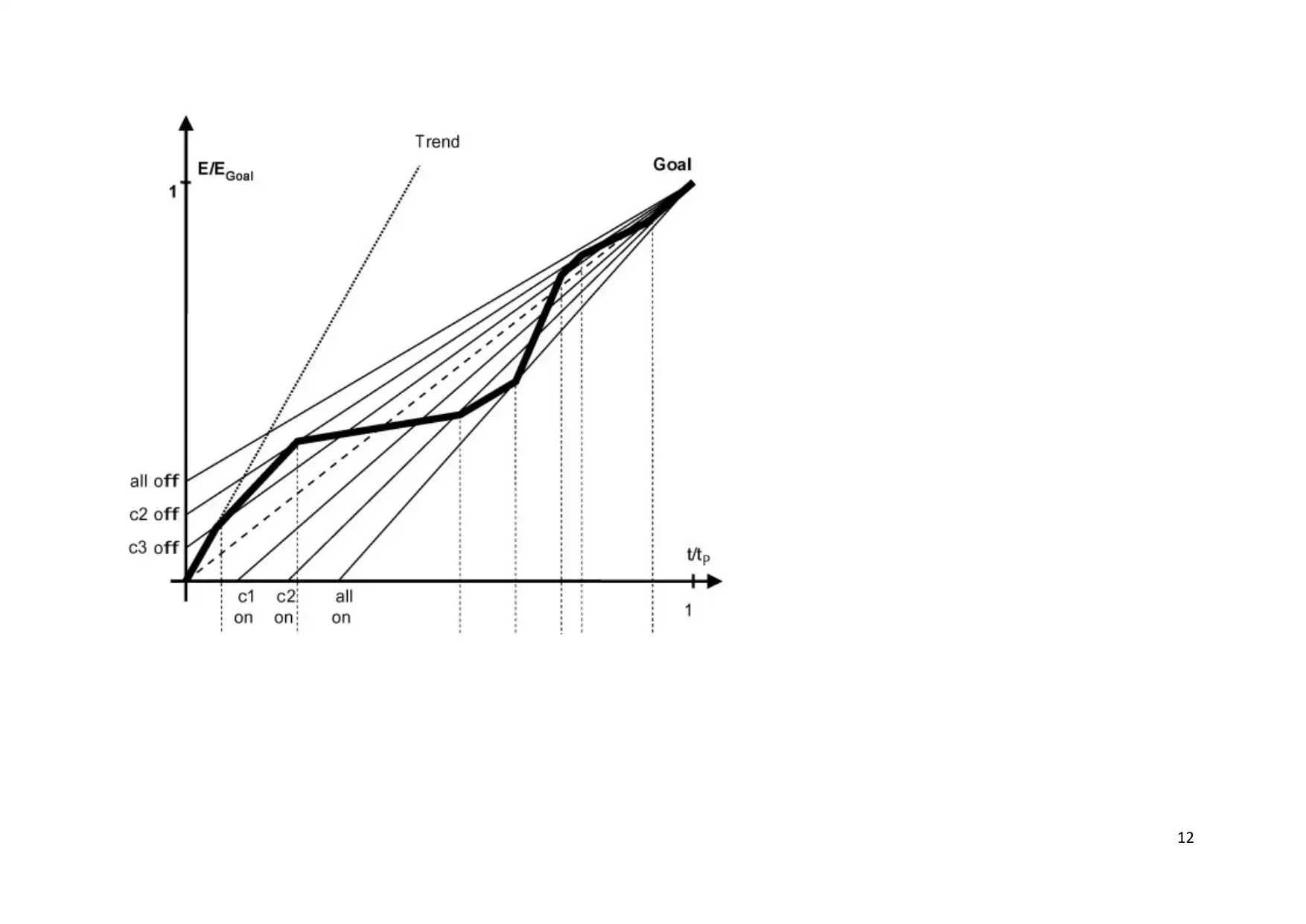
12
⊘ This is a preview!⊘
Do you want full access?
Subscribe today to unlock all pages.

Trusted by 1+ million students worldwide
1 out of 25
Related Documents
Your All-in-One AI-Powered Toolkit for Academic Success.
+13062052269
info@desklib.com
Available 24*7 on WhatsApp / Email
![[object Object]](/_next/static/media/star-bottom.7253800d.svg)
Unlock your academic potential
Copyright © 2020–2025 A2Z Services. All Rights Reserved. Developed and managed by ZUCOL.





